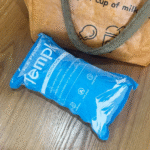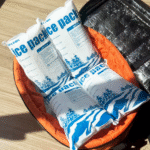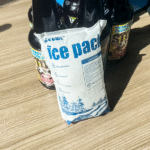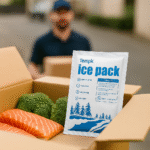The choice of gel dry ice pack can make or break a cold chain shipment. When you ship pharmaceuticals, fresh produce or meal kits, you need a cooling method that keeps your products within safe temperature ranges without breaking the bank. في 2025, shippers have more options than ever—flexible gel packs, super cold dry ice, reusable cold packs and even hybrid solutions. This comprehensive guide explains how gel dry ice pack options work and how to decide which one fits your situation. You’ll learn the pros and cons, current trends and actionable tips to keep your cargo safe and customers happy. Because temperature control isn’t optional, this guide makes it easy to navigate the complexities of cold chain packaging with confidence.
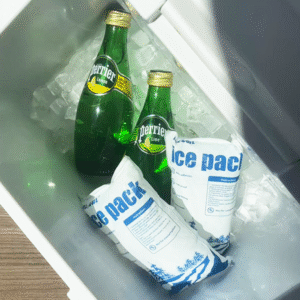
How do gel packs and dry ice work? – Learn the science behind each cooling agent and how they maintain specific temperature ranges.
What are the benefits and drawbacks of gel packs vs dry ice? – Compare cost, التعامل, regulation and environmental impact.
Which gel dry ice pack option fits your shipment? – Use our decision framework to choose the right method based on product type, distance and customer experience.
What are the latest 2025 trends in cold chain packaging? – Understand how technology, sustainability and market dynamics are reshaping cooling methods.
Practical tips and FAQs – Get actionable advice, real world scenarios and answers to common questions.
How Do Gel Packs and Dry Ice Work to Keep Shipments Cold?
Gel packs explained: Gel packs are flexible pouches filled with a non toxic refrigerant gel. عندما تجميد, the gel absorbs heat and slowly releases cold as it thaws. This makes them ideal for maintaining cool temperatures (typically 2–8 °C) for 24–48 hour shipments. Because gel packs do not reach extremely low temperatures, they won’t damage products that are sensitive to freezing, such as fresh produce or certain pharmaceuticals.
Dry ice explained: الجليد الجاف هو الشكل الصلب من ثاني أكسيد الكربون. It has a surface temperature of –109.3 °F (-78.5 درجة مئوية) and sublimates directly into gas rather than melting into liquid. أثناء التسامي, it absorbs significant heat, maintaining ultra low temperatures for an extended period. Dry ice is widely used to keep frozen goods such as seafood, ice cream and certain vaccines at sub zero temperatures.
Mechanisms of Cooling
Heat absorption and release: Gel packs absorb heat as the gel slowly transitions from solid to liquid. This process happens gradually, providing a stable cooling effect but limited duration. الجليد الجاف, على النقيض من ذلك, absorbs heat as it sublimates, releasing carbon dioxide gas and providing very low temperatures for a shorter period.
نطاق درجة الحرارة: Gel packs maintain a 2–8 °C range, making them perfect for chilled goods and pharmaceuticals. Dry ice keeps products frozen at –78.5 °C and is suited to deep freeze applications.
Handling requirements: Gel packs are non hazardous and safe to handle without special equipment. Dry ice requires insulated gloves and proper ventilation due to the risk of frostbite and CO₂ buildup.
Differences in Use Cases
| عامل التبريد | نطاق درجة الحرارة | Best Applications | التعامل & Regulation | التأثير البيئي |
| حزم هلام | 2-8 درجة مئوية | المنتجات الطازجة, جبن, ألبان, البضائع المخبوزة, الشوكولاتة, certain pharmaceuticals | Non toxic, لا لوائح خاصة, قابل لإعادة الاستخدام | Safe disposal; lower carbon footprint than dry ice |
| الجليد الجاف | -78.5 درجة مئوية | Frozen meats, بوظة, vaccines and biological samples | Hazardous material; requires gloves and ventilation; subject to shipping regulations | Emits CO₂ during sublimation; high carbon footprint; requires responsible handling and disposal |
| عبوات باردة قابلة لإعادة الاستخدام | عامل | Subscription services, pharma deliveries, B2B shipments; return logistics required | متينة; need cleaning and refreezing infrastructure | Lower long term cost; يقلل من النفايات |
Practical Implications for You
Trip duration matters: Gel packs provide reliable cooling for 24–48 hours, suitable for overnight or two day deliveries. Dry ice lasts 12–24 hours but offers colder temperatures.
Product sensitivity: Use gel packs for items that must not freeze; they maintain a safe chilled range without causing freeze damage. Dry ice is essential for goods that need to stay frozen solid.
Shipping regulations: يصنف الثلج الجاف على أنه مادة خطرة; carriers may impose limits and require special labels. Gel packs face no such regulations and are easier for customers to handle.
التأثير البيئي: Gel packs are reusable and non toxic, whereas dry ice releases CO₂ into the atmosphere. Responsible disposal and proper ventilation are critical.
Comparing the Pros and Cons of Gel Packs vs Dry Ice
Benefits of Gel Packs
Reusable and cost effective: Gel packs can be refrozen and reused, reducing long term costs.
Non toxic and food safe: They pose no health risks if they contact food.
خيارات درجة حرارة مرنة: Gel packs come in multiple formulations, including phase change materials tailored to specific temperature ranges.
Easy disposal: Most gel packs contain environmentally friendly substances and can be disposed of safely.
لا لوائح خاصة: Shippers and customers face no regulatory hurdles when using gel packs.
Limitations of Gel Packs
Limited cooling duration: Gel packs provide cooling for shorter periods (حتى 48 ساعات) and may not work for long-haul shipments.
Bulk and weight: They add bulk and weight to packages, increasing shipping costs.
Insufficient for freezing: They cannot maintain sub zero temperatures; للبضائع المجمدة, الثلج الجاف ضروري.
Benefits of Dry Ice
Ultra low temperatures: Dry ice maintains temperatures as low as –78.5 °C.
Longer cooling period: In insulated containers, dry ice can last longer than gel packs, making it suitable for extended shipments or hot climates.
لا بقايا سائلة: الجليد الجاف يسامي مباشرة إلى الغاز, eliminating moisture that could damage packages.
Ideal for frozen goods: It is critical for items that must remain frozen solid (على سبيل المثال, اللحوم المجمدة, بوظة, لقاحات معينة).
Limitations of Dry Ice
Safety hazards: Handling dry ice without gloves can cause frostbite. Sublimated CO₂ may cause suffocation in enclosed spaces.
Regulatory complexity: It is classified as hazardous and subject to shipping limits and labeling requirements.
Shorter duration and volatility: Dry ice sublimates continuously; تأثير تبريده يتضاءل بمرور الوقت. Spot shortages and price volatility can occur due to limited CO₂ supply.
Environmental footprint: يؤدي التسامي إلى إطلاق ثاني أكسيد الكربون في الغلاف الجوي. Sustainability concerns push companies to look for greener alternatives.
How to Choose the Right Gel Dry Ice Pack for Your Shipment
Selecting a cooling method is easier when you break the decision into specific factors. Use the guidelines below to match the right gel dry ice pack to your shipment.
Key Factors to Consider
Product characteristics: Determine whether your product requires refrigeration (2-8 درجة مئوية) أو التجميد. المنتجات الطازجة, جبن, pharmaceuticals and meal kits generally need chilled conditions and work well with gel packs. Frozen meats, ice cream and biologics require sub zero temperatures provided by dry ice.
Shipping duration and distance: For same day or next day deliveries, gel packs usually suffice. For multi day or long haul shipping, dry ice or reusable cold packs might be necessary.
Regulatory environment: If your shipment is subject to strict regulations (على سبيل المثال, الأدوية), ensure your cooling method complies. Dry ice requires hazard labels and may be banned on certain routes. Gel packs bypass these issues.
Customer handling: Consider the end recipient’s ability to handle the packaging. Customers unfamiliar with dry ice might be safer using gel packs.
Environmental goals: If sustainability is a priority, explore reusable gel packs or hybrid systems that reduce CO₂ emissions. Dry ice can be paired with gel packs to reduce the amount needed and extend cooling.
Decision Flow Example
Identify temperature needs: Are your goods perishable but not frozen? Choose gel packs. Are they frozen or ultra cold? اختر الثلج الجاف.
Assess trip length: Under 48 hours with moderate temperatures: حزم هلام. زيادة 48 hours or hot climates: dry ice or hybrid solutions.
Consider regulations and handling: If you want simplicity and fewer regulations, gel packs are best. If you can handle hazardous materials and need freezing, dry ice works.
Evaluate environmental impact: Use reusable or drain friendly gel packs to reduce waste. Consider hybrid solutions that use less dry ice.
Plan packaging: Use insulated liners or vacuum panels to extend cooling. Strategic placement of gel packs or dry ice around the product ensures even temperature distribution.
مثال الحالة: A meal kit company sends weekly subscription boxes containing fresh vegetables, pre portioned meat and a frozen sauce. They use gel packs around the produce to maintain 2–8 °C and a small amount of dry ice near the sauce to keep it frozen. This hybrid approach keeps everything at the right temperature, complies with shipping regulations and minimizes the amount of dry ice used.
More Detailed Considerations
Packaging Design and Insulation
Good insulation reduces the amount of refrigerant required. Materials like vacuum insulation panels (كبار الشخصيات) and multi layer foams provide superior thermal resistance. Advanced packaging companies incorporate smart sensors and IoT devices to monitor temperature in real time and alert shippers to deviations. Upgrading insulation can allow you to choose smaller gel packs or reduce dry ice usage.
Logistics and Return Systems
Reusable cold packs are cost effective when return logistics are feasible. Subscription services, pharmaceutical distribution and B2B loops can recover packs, clean and refreeze them for repeated use. Consider your distribution model before investing in reusable systems.
الحلول الهجينة
Many shippers combine gel packs and dry ice. Placing gel packs around the product and small dry ice pieces on top prolongs cooling and reduces the risk of freezing items that must stay chilled. Advanced phase change materials (PCMS) offer specific melting points, allowing you to tailor temperature profiles even further. Explore PCMs for shipments requiring strict temperature ranges without the extreme cold of dry ice.
2025 Trends and Innovations in Gel and Dry Ice Packs
التطورات التكنولوجية
Cold chain packaging is evolving from reactive containment to proactive, data driven systems. Sensor technologies and data analytics enable real time monitoring of shipments, providing immediate alerts when temperatures deviate. Stakeholders can intervene quickly, reducing spoilage and enhancing compliance.
Companies are developing advanced phase change materials and vacuum insulation panels to maintain desired temperatures with less refrigerant. Smart packaging includes RFID tags and IoT devices that track conditions throughout transit. These innovations transform packaging from a static container into an intelligent asset.
Sustainability and Regulation
Sustainability is a top priority in 2025. Businesses are pressured to reduce CO₂ emissions and plastic waste. حزم هلام, particularly drain friendly or biodegradable designs, help meet these goals. Some gel packs are made with kraft paper and can be disposed of through regular waste streams. Reusable cold packs reduce single use materials.
Dry ice usage faces scrutiny due to CO₂ emissions and supply constraints. The supply of industrial CO₂ has grown only 0.5 % سنويا, while dry ice consumption is rising at about 5 %. Spot prices can surge 300 % during shortages. To address these challenges, manufacturers are investing in localized CO₂ capture, including bio based sources such as bioethanol fermentation. This allows for more sustainable dry ice production and reduces transportation distances.
Market Dynamics
The global dry ice market, valued at USD 1.54 مليار في 2024, is projected to reach USD 2.73 مليار من قبل 2032 (CAGR 7.4 %). Demand is driven by food shipping, vaccine distribution and industrial applications such as dry ice blasting. لكن, CO₂ supply constraints and geopolitical factors—like the UK’s dependence on a few bioethanol producers—make the market volatile. Shippers are diversifying their cooling strategies by combining dry ice with PCMs and improving insulation to stretch each pound of dry ice.
Reusable cold packs and water based packs are also gaining traction. Water cold packs offer low cost, safety and ease of disposal. These packs strike a balance between performance and affordability for 2–8 °C products. The reusable ice pack market is expected to grow at a CAGR of about 5.5 % between 2025 و 2029, driven by increasing demand for food delivery and pharmaceuticals.
Sector Specific Trends
طعام & meal kit delivery: Water or gel packs remain the preferred option due to low cost and safety. Better insulation and localized cold pack production help scale these models.
Pharmaceutical logistics: Cold chain companies are testing barrier technologies that slow CO₂ gas release to prevent temperature spikes. Reusable PCM shippers are gaining ground for less temperature critical medicines.
أغذية مجمدة / بوظة: Dry ice remains indispensable. لكن, improved insulation and hybrid solutions reduce the amount of dry ice needed.
Dairy and cheese: Gel or water packs are recommended to maintain the 2–8 °C range without freezing.
Subscription services: Reusable cold packs are ideal when return logistics are feasible.
Common Questions About Gel Dry Ice Packs
How long do gel packs stay cold? Gel packs generally maintain a 2–8 °C environment for 24–48 hours. The actual duration depends on the starting temperature, the number of packs used, insulation quality and ambient conditions.
Can dry ice be combined with gel packs? نعم. Hybrid packaging uses gel packs to provide a base cooling level and small amounts of dry ice to maintain frozen sections. This combination prolongs the cooling period and reduces the risk of freeze damage.
Is dry ice safe for shipping food? Dry ice can be used safely when products are completely sealed. It should never touch food directly, and packages must include hazard labels. Consumers should use gloves and proper ventilation when removing dry ice.
What are drain friendly gel packs? Drain friendly gel packs contain water based gels that can be safely poured down the drain when melted. They reduce environmental impact and make disposal easier.
Are there regulations for gel pack disposal? Gel packs are generally considered non hazardous, but local recycling or waste regulations may apply. Always follow manufacturer instructions and recycle outer packaging when possible.
How do I decide between gel packs and dry ice? Evaluate your product’s temperature requirements, مدة الشحن, regulatory constraints, customer handling and environmental goals. Use the decision flow outlined above to make an informed choice.
Tips and Best Practices for Using Gel and Dry Ice Packs
Optimise insulation: Use high quality liners, such as vacuum panels or recyclable foam, to reduce the amount of refrigerant required.
Pre condition products: Freeze or refrigerate your products before packing so that refrigerants don’t expend energy cooling warm items.
Balance pack placement: Place gel packs or dry ice evenly around the product to ensure uniform temperature distribution. للثلج الجاف, position it on top because cold air sinks.
مراقبة درجة الحرارة: Use data loggers or smart sensors to monitor temperature throughout transit. This not only ensures compliance but also provides evidence in case of claims.
Educate customers: Provide instructions for safe handling and disposal, especially when dry ice is involved. Clear labeling reduces the risk of injury and ensures proper disposal.
Plan for returns: If using reusable cold packs, establish a return program with incentives. Clean and refreeze packs promptly to maintain their performance.
Practical scenario: A direct to consumer seafood retailer uses dry ice to maintain sub zero temperatures but pairs it with a biodegradable gel pack that sits around the outer edges. Customers are instructed to remove the gel pack and dispose of it in regular waste or reuse it. This method keeps seafood frozen, reduces the volume of dry ice needed, and aligns with sustainability goals.
ملخص وتوصيات
Choosing between gel and dry ice packs is not a one size fits all decision. Gel packs provide safe, cost effective cooling for chilled products and shorter journeys, while dry ice offers ultra cold temperatures for frozen goods. Hybrid solutions that combine gel packs, dry ice and advanced insulation optimise performance and sustainability. في 2025, innovations like smart sensors, phase change materials and localised dry ice production are reshaping cold chain logistics. Evaluate your product requirements, shipping distance and environmental goals, and select the cooling method that ensures product integrity and customer satisfaction.
خطة العمل
Analyse your shipment needs: Identify whether you need chilled or frozen conditions. Use a simple questionnaire or calculator to quantify the number and type of packs required.
Choose the right refrigerant: Select gel packs for chilled items and dry ice for frozen goods. Consider hybrid strategies for mixed shipments.
Invest in insulation and monitoring: Upgrade packaging with high performance liners and include temperature data loggers.
Educate and communicate: Provide clear handling instructions and return guidelines to recipients.
Contact Tempk for expert solutions: Our team at Tempk can design customised cooling strategies tailored to your products and logistics. Get in touch to learn how our gel and dry ice packs can optimise your cold chain.
حول Tempk
Tempk is a leading provider of temperature controlled packaging solutions in the cold chain industry. We specialise in designing gel packs, dry ice packs and phase change materials that maintain product integrity across the supply chain. مع التركيز على الاستدامة, we offer drain friendly gel packs and reusable PCM systems that reduce waste and carbon emissions. Our engineers combine decades of experience with the latest technologies to deliver reliable, compliant and environmentally responsible solutions for food, pharmaceuticals and industrial goods. Let us help you protect your products and delight your customers.
على استعداد لترقية سلسلة البرد الخاصة بك? Contact us today for a free consultation and discover how Tempk’s gel and dry ice pack solutions can transform your shipments. We look forward to partnering with you on your journey to temperature controlled excellence.
















